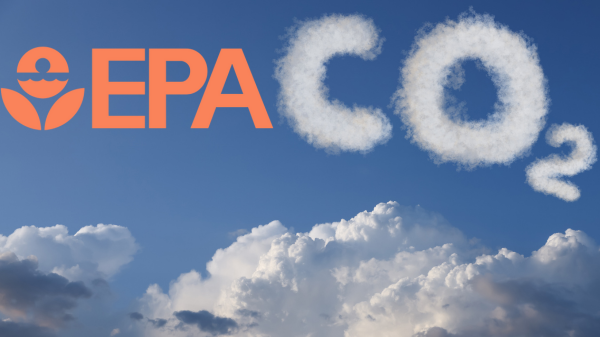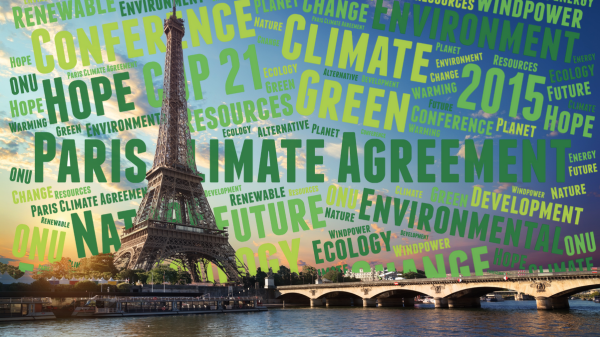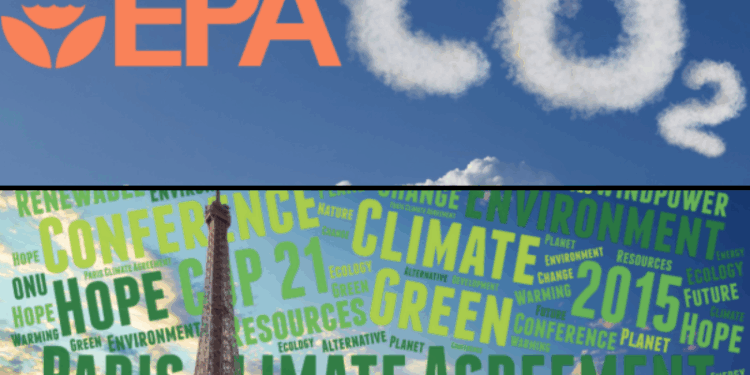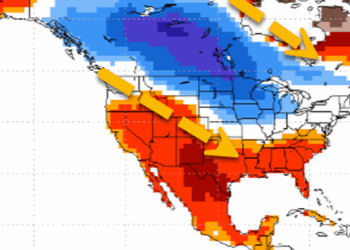IN THIS ISSUE:
- EPA Is Right to Rescind Its Greenhouse Gas Endangerment Finding. Here’s Why.
- Governments Are Off Track to Meet Climate Goals

EPA Is Right to Rescind Its Greenhouse Gas Endangerment Finding. Here’s Why.
The U.S. Environmental Protection Agency has proposed rescinding its endangerment finding for greenhouse gas emissions for motor vehicles. The endangerment finding was largely a creation of an activist Supreme Court extending the Clean Air Act. We at Heartland, along with our allies who have sued to overturn the finding since its inception, argue the finding was never justified as a matter of science or the law. As such, and with an additional 16 years of evidence and new Supreme Court rulings and executive orders in hand, now is the time to scrap the rule that serves as the underpinning for the Green New Scam and fossil fuel restrictions across the entire economy.
The extended comments that I filed for the record are below.
Comments on the U.S. Environmental Protection Agency’s “Reconsideration of 2009 Endangerment Finding and Greenhouse Gas Vehicle Standards”
Docket ID No. EPA-HQ-OAR-2025-0194
A reconsideration of the U.S. Environmental Protection Agency’s (EPA) Endangerment Finding for Greenhouse Gas Standards for Motor Vehicles (hereinafter referred to as the “endangerment finding) is long overdue. The endangerment finding was both unjustified as a matter of science and illegitimate as a matter of law from its inception.
Concerning the scientific basis of the endangerment finding, from the outset it was clear carbon dioxide (CO2), methane, nitrous oxide (N2O), hydrofluorocarbons (HFCs), perfluorocarbons (PFCs), and sulfur hexafluoride (SF6) did not qualify as pollutants under the Clean Air Act (CAA) as written or intended by Congress. Domestic motor vehicle greenhouse gas emissions pose no risk to people’s health or welfare at a national or regional level at any reasonably foreseeable atmospheric concentrations.
In 2009, in a hubristic leap of mission creep, the EPA administrator determined that public health and welfare were threatened by the indirect impact of greenhouse gases as a driver of climate change, such as possibly driving more extreme weather, or deaths from diseases and temperature extremes. Such indirect effects from emissions are, if anything, global in cause and not preventable by domestic action limiting emissions from U.S. motor vehicles. Yet on that tenuous basis, the EPA administrator then discovered that the agency had the “procedural discretion” to regulate such emissions. Not because the law explicitly directed or allowed the agency to do so, but because the CAA was “silent on [the] issue.”
To be clear, laws are silent on the vast majority of human actions and interactions, and this has never meant a grant to regulatory agencies to insert themselves into the myriad personal and professional decisions people make with mandates directing specific types of decisions. Where the law is silent, people are free to act and interact, unless and until the legislature, acting within its constitutional bounds, decides to legislate, resulting in regulations that limit such decisions. Congress alone, not the executive nor the Supreme Court, is specifically delegated the power to make laws.
Scientifically, there is little or no doubt that climate change is occurring, as it always has. A static “climate” globally or regionally has never existed in history. There is also little doubt that humans are contributing to the present change, although to what degree and in what ways, at global and regional levels, are very much still open to debate.
It is also clear from the scientific record so far that the present change has proven beneficial to human health and welfare, rather than harmful. Higher CO2 concentrations have boosted plant productivity, resulting in a dramatic greening of the Earth, including improving crop yields and production, resulting in reduced starvation and malnutrition globally. The recent modest warming has resulted in a dramatic decline in temperature related deaths. Multiple large-scale peer reviewed studies show that cold temperatures and associated weather kill far more people than hot temperatures. As the Earth has slightly warmed, deaths from non-optimum temperatures have fallen significantly.
By contrast, the much ballyhooed and feared predicted catastrophic harms from climate change have yet to materialize. As detailed in the peer reviewed literature and data presented in the Climate at a Glance series of articles, almost no type of extreme weather event has become more frequent, severe, longer lasting, or deadly during the present period of climate change.
Neither hurricanes nor cyclones, droughts, heatwaves, floods, tornadoes, nor instances of extreme cold, have become more frequent or severe during the present period of or in response to climate change. In fact, some types of extreme weather events have even become less frequent or severe. In addition, deaths attributable to extreme weather have declined dramatically—especially as technologies powered by or consisting in part of hydrocarbons have been more widely adopted and incorporated into peoples’ everyday lives. These points are not debatable; they are fact grounded in real-world data.
Even the U.N. Intergovernmental Panel on Climate Change reports in Chapter 12 of its most recent Physical Science Assessment Report, that for most categories of extreme weather it has neither detected any dangerous change nor can it attribute dangerous changes with high levels of confidence to human activities.
Since there is no readily identifiable harm, there is no scientifically justifiable basis for the endangerment finding.
DOE Secretary Chris Wright recently said:
Climate change is real, and it deserves attention. But it is not the greatest threat facing humanity. That distinction belongs to global energy poverty. As someone who values data, I know that improving the human condition depends on expanding access to reliable, affordable energy. Climate change is a challenge—not a catastrophe. But misguided policies based on fear rather than facts could truly endanger human well-being.
The endangerment finding and the various regulations that agencies have developed in response to it are what threaten human health and well-being, not greenhouse gas emissions.
As the EPA now admits, Section 202 of the CAA authorizes the agency to regulate emissions of chemicals from motor vehicles that directly compromise human health in one way or another, but the greenhouse gas emissions do not do so at any reasonably expected atmospheric concentration. Any indirect harm to human health or welfare due to impact on climate is extremely speculative, largely based on flawed computer model projections and can’t be found in the data. They are a small part of U.S. emissions, and even a smaller, virtually unmeasurable source percentage of global concentrations overall. In short, it is impossible to reasonably tie U.S. vehicle emissions of greenhouse gases to direct human health or welfare impacts. It is also factually impossible to show such emissions correlate to dangerous changes in the climate, much less any causal connection to such changes—because no such changes are evident.
When, contrary to the federal government’s position in Massachusetts v. EPA, the U.S. Supreme Court opened the door for the regulation of greenhouse gases as pollutants if endangerment was found by the EPA for climate change reasons, the court’s majority was making up the law, not following it as written by Congress and understood by the writers of the law, as the latter have said in their own words. Despite Congress considering legislation directly regulating greenhouse gases, no such legislation has been adopted, and when those bills were considered, no one suggested that the EPA already has such authority under the CAA. Nor has the U.S. government signed onto any treaty that would specifically bind it to enact federal laws to limit greenhouse gas emissions from motor vehicles, power plants, or from any other sector of the economy.
The Massachusetts v. EPA ruling was nothing more nor less than a majority of the U.S. Supreme Court at the time implementing its preferred social and economic policy goals via finding new authority for the EPA to regulate non-toxic motor vehicle emissions. Under the Obama administration, the EPA’s administrator was more than happy to exercise discretion and expand the agency’s power.
Massachusetts v. EPA was the equivalent of the Supreme Court’s earlier, now rescinded, Roe v. Wade decision, in the realm of environmental policy. The court made up authority and rights to regulate found neither in the law, nor the Constitution, in this case giving individuals and states the right to force the federal government to adopt regulations delegated explicitly to Congress in the Constitution both as the sole legislative authority and as the only branch delegated the power to regulate interstate commerce.
More recently, in West Virginia v. EPA, the Supreme Court, while not directly overturning Massachusetts v. EPA, which was not in contention in the case, did reexamine the scope of the EPA’s authority with regard to “major questions.” In West Virginia v. EPA, the court held with regard to greenhouse gas emissions regulations for power plants that EPA had “exceeded its statutory authority when it interpreted the Clean Air Act to require . . . permitting for stationary sources based on their greenhouse gas emissions” and “may not treat greenhouse gases as a pollutant.” The Court reasoned the EPA’s claim of such authority was “unreasonable because it would bring about an enormous and transformative expansion in EPA’s regulatory authority without clear congressional authorization . . . [and as such] a measure of skepticism [is required when] an agency claims to discover in a long-extant statute an unheralded power to regulate ‘a significant portion of the American economy.’”
What is true of power plant greenhouse gas emissions is equally or even more true of such emissions from motor vehicles. If anything is a “major question,” the ability to regulate human emissions of CO2, one of the most ubiquitous naturally occurring chemical compounds on Earth, a compound actually vital to life on Earth, is a major question. With West Virginia v. EPA in hand, and President Donald Trump’s executive order directing agencies to repeal regulations that violate recent Supreme Court decisions, the EPA is not simply justified in rescinding the endangerment finding, it is legally required to do so.
Sources: The Heartland Institute; U.S. Environmental Protection Agency

Governments Are Off Track to Meet Climate Goals
NPR is reporting on a new study which shows countries backsliding in their carbon reduction commitments under the Paris climate agreement, falling far behind the cuts the negotiators of the Paris agreement deemed necessary to keep temperatures below the supposedly 1.5℃ tripwire for climate catastrophe. Although NPR is evidently just becoming aware of this fact, it is neither worrisome nor breaking news.
The fact that the world is on track to miss the temperature targets is not cause for concern: the 1.5℃ target and even the actual treaty goal of below 2.0℃ were both simply made-up political goals, with no scientific underpinning. No science showed that a global average temperature (also a made-up metric) increase of either 1.5 or 2.0 was a tipping point signaling irreversible catastrophic climate change, or that any such triggering temperature existed at all, or that the Paris goals would prevent such an increase in temperature. These claims were all fabrications of politicians, entrenched bureaucrats, and scientists reaping big research bucks and influence by preaching climate doom that only they could save us from.
NPR’s report doesn’t qualify as breaking news for anyone who has followed Climate Change Weekly (CCW) over the years. In December 2015, when the ink on the Paris agreement was barely dry, I wrote that it was a nonbinding paper tiger, doomed to fail. Why? Because, as then-Secretary of State John Kerry said at the time, “[i]t doesn’t have mandatory targets for reduction and it doesn’t have an enforcement, compliance mechanism.”
James Hansen, the former head of NASA’s Goddard Institute for Space Studies, often referred to as the “father of climate change,” gave an even more scathing critique of the agreement, telling The Guardian at the time, “It’s a fraud really, a fake. … There’s no action, just promises.”
Since then, CCW has given periodic updates on the progress countries were making toward their self-developed interim emission reduction targets, and the reports haven’t reflected well on the governments involved. Countries have been slow to develop firm goals, the goals they set have been uniformly insufficient to prevent the temperature rise set in the Paris agreement, and they’ve been failing to hit even the unambitious targets they committed to. Also along the way, they’ve been slow to submit new “nationally determined contributions” (NDCs). Concerning the latter, under the terms of the Paris agreement each country was required to submit updated, more-stringent emission reduction goals to the U.N. Framework Convention on Climate Change (FCCC) secretariat every five years. This requirement and many countries’ recent public reembrace of fossil fuels prompted NPR’s article.
Few of the nearly 200 countries party to the Paris agreement submitted their NDC targets by the 2020 deadline, and only approximately 15 countries submitted updated NDC commitments by the initial February 10, 2025 deadline. In embarrassment, the FCCC secretariat extended the deadline to September, by which time still only a quarter of the countries involved had submitted updated NDCs, with many of the highest-emission countries notably absent from the list.
NDC commitments aside, NPR writes,
The world is producing too much coal, oil and natural gas to meet the targets set 10 years ago under the Paris Agreement, in which countries agreed to limit climate pollution and avoid the worst effects of global warming.
A new report, led by the nonprofit research group Stockholm Environment Institute, shows countries plan to produce more than twice the amount of fossil fuels in 2030 than would be consistent with limiting global heating to 1.5 degrees Celsius (2.7 degrees Fahrenheit).
The SEI report shows the 20 most polluting countries, including China, the U.S. and India, actually plan to produce even more fossil fuels than they did two years ago, when the report was last updated.
The SEI report details the large gap between the Paris agreement goals and the actual trends—increased fossil fuel use despite promises to cut the same:
Governments have explicitly acknowledged the need to transition away from fossil fuels to achieve this goal, a conclusion now reinforced by an opinion of the International Court of Justice. Yet 10 years on from the Paris Agreement, the situation remains stark: Cumulatively, countries are planning even more fossil fuel production than before, putting global climate ambitions at increasing risk.
The increases in fossil fuel production estimated under the government plans and projections pathways would lead to global production levels in 2030 that are 500%, 31%, and 92% higher for coal, oil, and gas, respectively, than the median 1.5ºC consistent pathway. These plans and projections also collectively exceed the fossil fuel production implied by countries’ own climate mitigation pledges by 35% in 2030 and 141% in 2050.
Taken together, government[s] now plan even higher levels of coal production to 2035, and gas production to 2050, than they did in 2023. Planned oil production continues to increase to 2050. These plans undermine countries’ Paris Agreement commitments and go against expectations that under current policies global demand for coal, oil, and gas will peak before 2030.
Concerning the Paris climate agreement, like the various climate agreements before it, such as the 1997 Kyoto Protocol and the 1992 Earth Summit agreement forged in Rio, the parties to the agreement failed to meet their commitments. And just like before, despite emissions continuing to rise and persistent warnings of tipping points and doom, no catastrophic consequences have arisen.
Governments are for the most part self-interested. When the climate sacrifices called for by their peoples start to pinch, because those in power want to stay in power, they find reasons to keep their economies chugging along by maintaining the use of fossil fuels. Often they initially impose sacrifices on their respective countries’ economies, making the government look like international statesmen and paragons of climate virtue. They try to sell costly climate policies to their people as good for the planet, the economy, and the people themselves. However, because the schemes invariably retard economic growth, cost jobs, and rob people of comfort, freedom of choice, and for some even their lives, when the pressure becomes too high, like a tea kettle, governments act to relieve the pressure.
I’ve said it before: philosopher Thomas Hobbes identified the main problem endemic to many international agreements and treaties centuries ago, writing in Leviathan, “[C]ovenants, without the sword, are but words and of no strength to secure a man at all.”
So long Paris—we hardly knew ye!
Sources: NPR; Stockholm Environment Institute; Climate Change Weekly; Climate Change Weekly; Climate Change Weekly; Climate Change Weekly

















